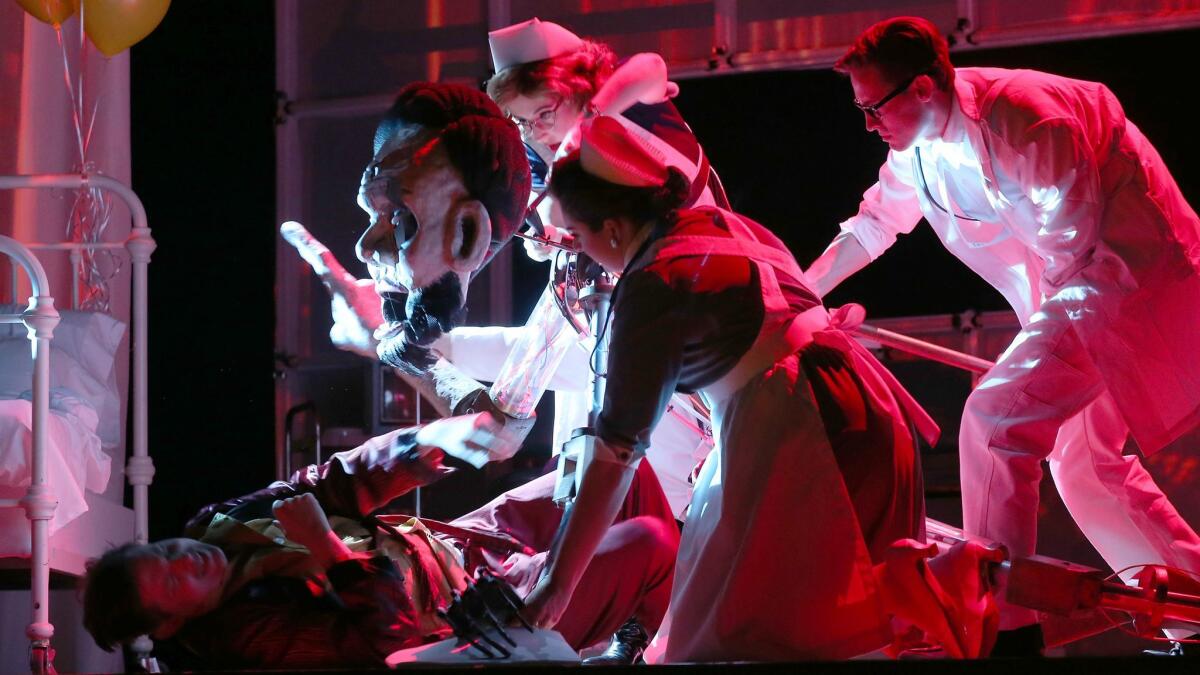How would the death of the NEA affect your community? California can cite 162 ways

On its way to Broadway, “Hamilton” benefited from support by the National Endowment for the Arts. So did “August: Osage County” and “Fun Home,” currently in production at Los Angeles’ Ahmanson Theatre.
But these high-profile productions are only a small part of what the NEA funds. The proposed elimination of the NEA and the National Endowment for the Humanities, announced Thursday in a 2018 budget blueprint from the Trump administration, would hit closer to home.
Murals by low-income students at probation centers. New works by Native American, Alaska Native and First Nations playwrights. Art outreach for the homeless of skid row and South L.A.
These programs and organizations are among the 162 in California listed in a recent NEA grant announcement — a total of $4.4 million for this year.
These groups and the broader arts community responded loudly Thursday at the prospect that future work could be in jeopardy. “Devastating,” “outrageous,” “regrettable” and “heartbreaking” were among the responses to the proposed cuts.
“If you don’t value the arts, you don’t value humanity,” said Lula Washington, co-founder of the Lula Washington Dance Theatre. “The elimination of the NEA will be a blemish on America.”
Los Angeles County Museum of Art Director Michael Govan was concerned but hopeful, as Congress, not the president, ultimately writes the federal budget.
“There has never been a great civilization that has not supported the arts,” Govan said. “But my strongest feeling is of hope — that Congress will want to express the cultural strength and intelligence of a great nation through arts and culture.”
On Saturday, Long Beach Opera will stage its second and final performance of “The Perfect American,” composed by Philip Glass with a libretto by Rudy Wurlitzer. The project, an imagined look at the final days of Walt Disney, was made possible with $30,000 from the NEA.
Said Andreas Mitisek, the company’s artistic and general director: “$30,000 doesn’t seem like a lot of money to some, but in our universe, it is a lot of money. Cutting [the NEA] down is just devastating for us as a company — and a nation.”
Disney shaped the lives of so many artists and storytellers, Mitisek said, “and exploring all the different stories of humanity, that helps us understand who we are, where we come from, where we go, all the things that make us human.”
Added Mitisek: “I don’t consider what we do entertainment. It’s essential for who we are as human beings.”
A $30,000 grant for the Cornerstone Theater Company of L.A. is going toward investigating hunger and enlightening the public about its shattering effects. Artistic Director Michael John Garces’ “The Hunger Bridge Show” is a theater piece in which community participants appeared onstage alongside actors relaying their needs, fears and hopes.
Cornerstone Managing Director Megan Wanlass said the proposed NEA cuts would have a snowball effect going forward, a sentiment echoed by other organizations Thursday.
“The NEA gives money to state arts councils, so it’s a multiplying effect, as well as the fact that when your organization receives an NEA grant from the federal government, it’s a ‘Good Housekeeping seal of approval.’ We’re able to help leverage other funding with that approval — it’s a ripple effect. Already, we’re talking about posting on social media that we are opposed — who do we write to? Our senators, our representatives — we have to make a stand.”
What’s particularly sad, Wanlass adds, is that “we’re not talking about a lot of money, it’s a drop in the bucket, but that is seed funding — it’s reliable and repeatable — you write for another project.”
The Autry Museum of the American West, meanwhile, has received more than $400,000 from the NEA in the last 15 years to fund the Native American equity theater company Native Voices. “It’s never really possible to completely cover this kind of arts endeavor through sponsorship and ticket sales, so we rely on funding from the NEA,” says W. Richard West Jr, president and chief executive of the Autry.
“I’ve been through this before,” added West, who served as director of the Smithsonian’s National Museum of the American Indian from 1990-2007. “The fact that it’s a small component of the discretionary budget of the U.S. and continues to be the target of this kind of cutting is outrageous. We spend less in this area than any industrialized country in the world.”
Smaller organizations such as the nonprofit Piece by Piece, which teaches free mosaic workshops to residents of Skid Row and South Central L.A., would find themselves “strapped” without the help of the NEA. Its programs, taught by professional artists, give “a strong sense of community and self confidence,” to participants, said program director Dawn Mendelson.
Underserved communities stand to lose the most, said Sheila Scott Wilkinson, the executive director of the arts education program Theatre of Hearts, which serves high-risk youth in community and probation centers and in low-income housing.
“Mr. Trump doesn’t understand that the CEO’s of the corporations he wants to move forward are looking for kids with creative minds,” she said, adding that she plans to resist the proposed cuts in every way possible.
“We’re firing up our cells and Twitter,” she said. “We’re not going to sit down and take it, and we’re going to fight for it.”
The organization’s NEA funding goes directly toward its skill-building program, which teaches students how to earn income through commissions. “We have a lot of people who are traumatized and trying to get back on their feet, and they need the support,” Mendelson said.
One of the main deadlines to apply for fiscal year 2018 NEA grants was March 2; applicants will receive a decision in November. .
A spokesperson for the NEA said that the organization’s 2017 operations, for now, remain unchanged.
Deaf West Theatre received $15,000 in support of “Edward Albee’s at Home at the Zoo,” running now at the Wallis Annenberg Center for the Performing Arts in Beverly Hills. South Coast Repertory in Costa Mesa received $50,000 for its Pacific Playwrights Festival in April, when the company presents readings and staged productions of new plays. Among the works to emerge from past festivals is Julia Cho’s “Office House,” which Times critic Charles McNulty championed as an example of work by a female playwright of color writing about the ways we interact with “the other.”
The Hammer Museum received $55,000 to stage the current exhibition of paintings, sculptures, drawings and videos of Jimmie Durham. For those who might question the relevance of such a show in their lives, Times art critic Christopher Knight delivered an opening line of his review that read: “Given deplorable declarations of American xenophobia now splashed across newspaper front pages, clogging social media outlets and upending television news shows, there could be no more impeccable a moment for a retrospective of Jimmie Durham’s art.”
Diavolo, the innovative Los Angeles troupe that often uses sophistical set pieces as part of its art, received $45,000 for the development and use of movement-based sensors, electronic textiles and other devices for a new dance piece. The Harmony Project and Heart of Los Angeles, the Los Angeles Philharmonic-affiliated program better known as YOLA at HOLA, are using their grants at least in part to provide music instruction for low-income and underserved communities.
Yuval Sharon, artistic director of the experimental opera company the Industry, was unavailable for an interview due to his rehearsal schedule, but he forwarded a speech he delivered before the company’s Feb. 25 performance of “Bonnie & Clyde.”
Despite the potentially cataclysmic consequences of the proposed budget cuts, Sharon remained indignantly optimistic.
“Do they really think that they will silence us?” Sharon said. “Artists in this country have faced derision and disrespect from our government for at least as long as I’ve been alive — and we’ve only grown more resilient and more resourceful because of it. Because art is freedom, and freedom and art always find a way.”
ALSO
Trump says budget plan with deep cuts sends ‘America first’ message
These are the 19 agencies Trump would stop funding entirely
Art Critic: National Endowment for the Arts works. Why does Trump want to destroy it?
More to Read
The biggest entertainment stories
Get our big stories about Hollywood, film, television, music, arts, culture and more right in your inbox as soon as they publish.
You may occasionally receive promotional content from the Los Angeles Times.












